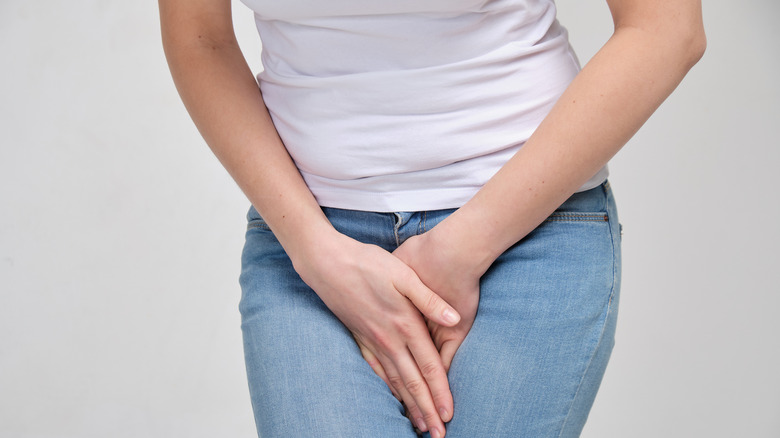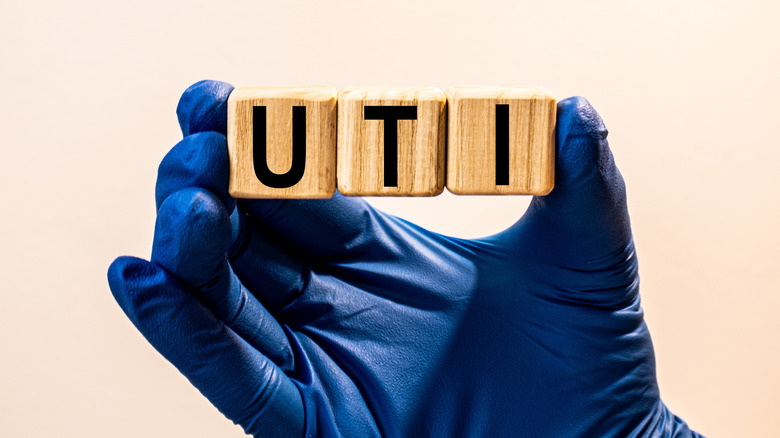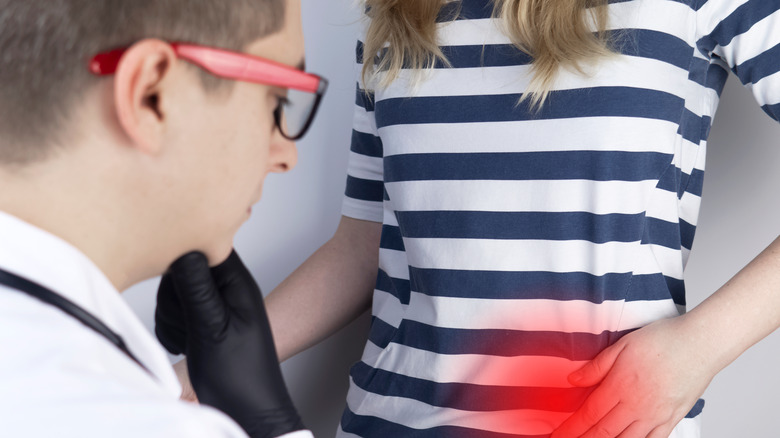Here's Why Your Groin Hurts
Do you have groin pain when walking, running, or standing up from a sitting position? First of all, don't panic. While it's true that groin pain can be a sign of kidney stones, inguinal hernia, or appendicitis, that's not always the case. This symptom is typically due to minor injuries, such as a strained muscle, according to the Mayo Clinic. In rare cases, it may indicate a more serious condition. Its exact cause depends on what other symptoms you experience.
Some of the conditions that may result in groin pain are specific to women. For example, ovarian cysts can cause lower abdominal pain that radiates to the hip and groin, explains Healthline. In this case, you may also experience bloating, heavy or irregular periods, breast tenderness, and pain during sex, among other symptoms. Endometriosis, a condition characterized by tissue overgrowth outside of the uterus, causes similar problems.
Generally, pain that occurs after exercise or during specific movements, such as squatting or running, is a sign of injury. If your symptoms are due to a condition affecting the bones or internal organs, then you'll have constant or intermittent pain.
You might have a groin strain
The groin area consists of several muscles, including the iliopsoas, adductors, rectus abdominis, and obliques. Any of these muscles can become strained due to overuse, strenuous workouts, or repetitive movements. Physiopedia explains that groin strains are common among athletes, especially those playing sports that involve twisting, sprinting, or kicking.
Depending on the type and severity of your injury, you may experience groin pain, weakness, backaches, limited range of motion, or diminished strength. Other symptoms may include bruising, swelling, or tenderness in the groin area and pain when raising your knee (per Berkshire Healthcare NHS Foundation Trust). The pain can radiate down the inner thigh.
Groin strains are usually treated with physiotherapy, ice and heat therapy, or compression. Surgery is only recommended in severe cases, notes Physiopedia. To stay on the safe side, reach out to a physical therapist or personal trainer with experience in sports injuries. If your symptoms persist, see your doctor for further investigation. He may order additional tests to rule out appendicitis, hip arthritis, stress fractures, and other potential causes of groin pain.
Get tested for urinary tract infections
Groin pain may also be due to urinary tract infections (UTIs), warns PeaceHealth. Most UTIs are caused by K. pneumonia, Enterococcus faecalis, S. saprophyticus, or other bacterial species and can affect both men and women. A 2019 review featured in the journal Therapeutic Advances in Urology reports that 50 to 60% of adult women will experience this condition at some point in their lives. The risk increases with age.
UTIs typically cause several other symptoms in addition to groin pain. These can include pelvic pain, lower back pain, blood in the urine, or the urge to pee despite having an empty bladder. You may also notice that your urine is cloudy or has a foul odor, notes the Urology Care Foundation. Simple UTIs are treated with a short course of antibiotics. A complicated UTI, on the other hand, requires prolonged antibiotic therapy and can lead to kidney infections. In either case, the infection can return after treatment.
Pelvic inflammatory disease can cause groin pain in women
The organization PeaceHealth reports that pelvic inflammatory disease is a common cause of groin pain. This condition affects about 800,000 to 1,000,000 American women each year, leading to lifelong complications, per Infection and Drug Resistance. In some cases, it's the culprit behind chronic pelvic pain and infertility.
Pelvic inflammatory disease is often due to bacterial infections and tends to affect young women. In general, it's more common in those who use intrauterine contraceptive devices (IUDs), have multiple sex partners, or practice douching. Untreated sexually transmitted infections can play a role, too, according to the Centers for Disease Control and Prevention. In addition to groin pain, you may experience bleeding between periods, as well as an abnormal discharge and painful urination. Early diagnosis may help prevent complications and increase your chances of recovery. If you can, before visiting a doctor, take note of your symptoms and try to identify a pattern. For example, groin pain that occurs while running may indicate an injury to the iliopsoas, adductors, or other muscles and tissues.
Sometimes, groin pain is a sign of arthritis, kidney stones, or hip problems, says PeaceHealth. A herniated disc and other spine disorders may cause aches in the groin area, too. Many of these conditions have non-specific symptoms and can be difficult to diagnose. The best thing you can do is to see a doctor if the pain lasts longer than a few days.




